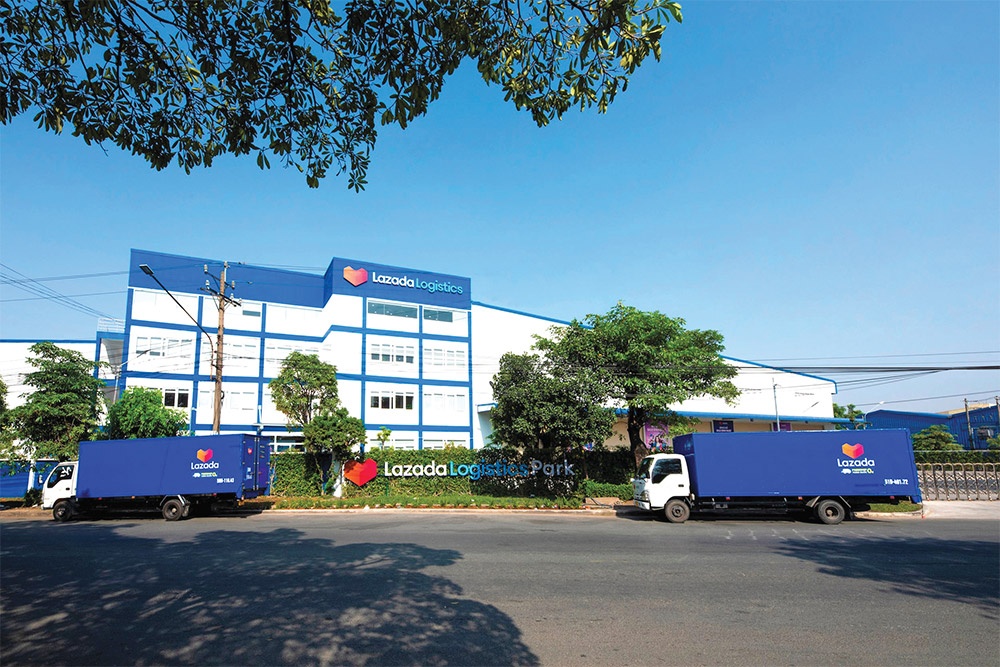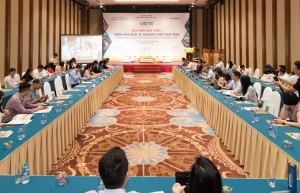Logistics firms take alternative steps
Over the past weeks, the Business Planning Department of Vietnam Railways (VNR) has been working on more contracts from businesses after Red Sea tensions forced them to find alternative means of transportation.
 |
| Logistics firms take alternative steps |
Nguyen Chinh Nam, head of VNR’s Business Planning Department, said, “We have received some more contracts in recent times. The amount of goods exported to China increased the most, followed by transit goods exported from Vietnam to third markets via China such as Europe, Central Asia, Mongolia, and others. Our international transport output increased by more than 40 per cent on-year.”
An Tin Logistics is one firm that has found an alternative rail solution, reducing shipping time and risks for customers. According to a representative, instead of going directly from Vietnam via the Suez Canal, which takes 45 days, or going through the Cape of Good Hope, which takes 55 days, export businesses can go by rail from Vietnam to China and then to Europe in just 27 days. Compared to sea transport, the outstanding advantage of the Vietnam - China - Europe railway cargo route is more stable.
“By doing this, we have received the support of many export businesses because it optimises shipping time, promptly delivers goods to partners, and avoids order cancellations, and protects business reputation. In addition to significantly reducing transportation time, it helps save logistics costs, improves capital turnover and enhances product competitiveness for businesses,” he said.
“Currently, although rail transport is only used for consumer goods and common household appliances, such as garments, or canned and bottled foods, for agricultural products that do not require refrigeration, it has eased worries among businesses, and these are all key export items of Vietnam. We will keep close eyes on the situation, and work with partners to choose the most appropriate option in the logistics chains for each industry.”
According to the Vietnam Logistics Business Association (VLA), since the end of 2023, due to conflicts in the Red Sea, many shipping lines have had to change routes, not going through the Suez Canal but having to go around the Cape of Good Hope, lengthening ships’ journeys.
In 2023, Vietnam’s import-export turnover of goods is $71.14 billion with the European region and $122.3 billion with the North American region. The total import-export turnover of these two regions accounts for 28.4 per cent of the country’s total trade turnover value last year. Therefore, the Red Sea conflict causes a significant impact.
“The security crisis in the Red Sea is increasing costs, which has an impact on logistics enterprises of Vietnam as well as countries that export many goods to these areas. There is currently no improvement and no solution, so we continue to wait,” said Le Duy Hiep, chairman of the VLA. “We currently recommend that shipping lines increase costs in the spirit of sharing with customers, and avoiding profiteering.”
Despite interim challenges, there are potential opportunities for logistics companies in Vietnam. According to the VLA, Vietnam’s trade showed positive signs with a rise of 15.5 per cent in the first quarter of 2024, creating more opportunities for logistics companies. As a result, they have invested in infrastructure, IT, and automation to increase competitiveness.
Hiep said that because imports and exports occur across all provinces and cities, regional links are essential. “Therefore, coordination between provinces and regions is essential. There needs to be specific policies to enhance connectivity and promptly resolve difficulties,” he said.
In addition, green logistics are also changing the way they operate. Logistics businesses in Vietnam are increasingly investing in automation to increase competitiveness.
“There have been clear advances and transformations in digital transformation for logistics services, such as the majority of logistics businesses now apply electronic delivery orders, electronic bills, and electronic service invoices,” said Hiep.
He added that at seaports, they have applied the e-port model, electronic customs clearance of ships, and submission of documents to relevant authorities through software and online.
| Nguyen Thi Thanh Van, deputy director, Hanoi branch Bee Logistics Corporation The development of the economy and the import-export market increases the need for specialised logistics services. This opens up opportunities for logistics businesses to provide innovative and diverse solutions, from transportation to supply chain management. In addition, the Vietnamese government is investing heavily in transport infrastructure, including road, rail, waterways, and aviation. With a boom in e-commerce, demand for logistics services is increasing significantly. The development of IT has created changes in the industry, from applying AI to optimise delivery addresses to the use of smart warehouse management systems. Logistics businesses can take advantage of these new technologies to provide logistics solutions to meet the increasing needs of the market, from order processing to last-mile delivery, and from city to remote areas. This opens up the potential for logistics businesses in Vietnam to develop and expand their market. Despite the opportunities, Vietnam’s logistics industry is facing many challenges, including stiffening competition from international rivals, global uncertainties, a lack of qualified human resources, and high logistics costs. In 2024 and beyond, we focus on several main targets. Specifically, we will strengthen international cooperation and expand services to new markets in the Asia-Pacific region and globally, as well as enhancing the Bee brand presence on five continents. We will build new key products such as cross-border transportation services, establishing and effectively operating e-logistics, as well as focus on digitalisation, investing in IT to optimise operating processes, improve labour productivity, and improve customer experience. We continue to invest heavily in improving hard infrastructure such as warehouses, ports, and distribution centres. Bee Logistics will also look for investment opportunities in mergers and acquisitions to expand the scale and scope of operations. |
 | Vietnam International Logistics Exhibition 2024 to open in Ho Chi Minh City in August The Vietnam International Logistics Exhibition 2024 (VILOG 2024) will take place from August 1-3 at Saigon Exhibition & Convention Centre in Ho Chi Minh City. |
 | Logistics groups must work to mitigate Red Sea route tensions Instability in the Red Sea is affecting businesses in Vietnam, and demonstrating the prolonged weakness of the domestic logistics industry. |
What the stars mean:
★ Poor ★ ★ Promising ★★★ Good ★★★★ Very good ★★★★★ Exceptional
Related Contents
Latest News
More News
- Businesses ramp up production as year-end orders surge (December 30, 2025 | 10:05)
- Vietjet chairwoman awarded Labour Hero title (December 29, 2025 | 13:06)
- How to unlock ESG value through green innovation (December 29, 2025 | 10:03)
- AI reshapes media and advertising industry (December 29, 2025 | 08:33)
- FPT and GELEX sign deal to develop blockchain tech for global markets (December 29, 2025 | 08:29)
- Vietnam’s GDP forecast to grow by 9 per cent in 2026 (December 29, 2025 | 08:29)
- Women entrepreneurs are key to Vietnam’s economic growth (December 29, 2025 | 08:00)
- Vietnam's top 500 value-creating enterprises announced (December 27, 2025 | 08:00)
- The PAN Group shaping a better future with ESG strategy (December 26, 2025 | 09:00)
- Masan Consumer officially lists on HSX, marking the next phase of value creation (December 25, 2025 | 13:20)

 Tag:
Tag:




















 Mobile Version
Mobile Version